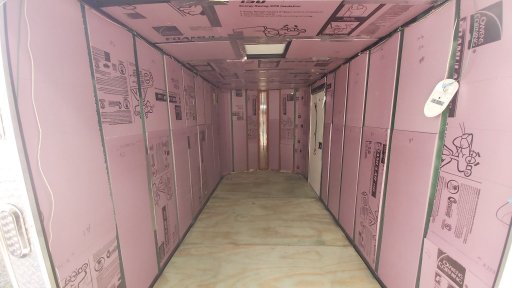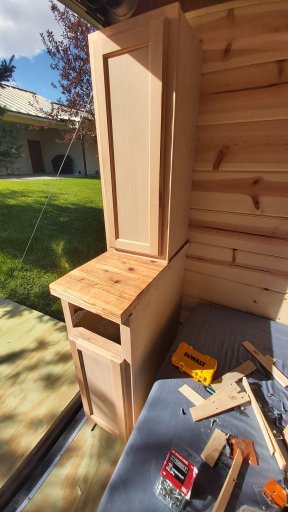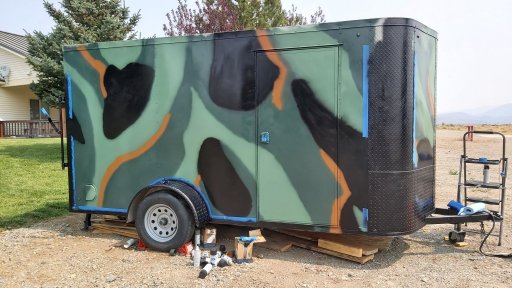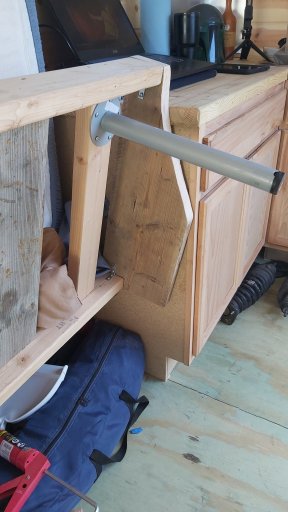
Member III
Hello! So I've mentioned/shown my trailer a few times in my ML build thread and figured I would create one for my trailer to show how I've built the trailer out.
There's a few reasons why I decided to go with a cargo trailer conversion versus something else.
I purchased the cargo trailer in March of 2020 during the initial Covid shutdowns in the US. The only reason why I was able to afford it was because of the federal boost to unemployment after I got laid off (and kicked out of employee housing and moved in with one of my friends who would help me with the trailer and ML build), and decided to buy a new trailer since all of the used ones in my area were damaged, rusted out, or just as expensive as a new one with obvious issues that would need to be fixed before continuing with the build.

In April of 2020 my job took me back and I started working again, making about $9/hr still living with my friend. Most jobs in my area didn't pay very much, and due to the pandemic most businesses weren't interested in hiring for much more than $10-12/hr which meant I couldn't afford housing on my own. My friend let me stay at his place so we could work on the trailer together while I continued working as a park ranger getting experience there so I could eventually start seasonal jobs and use the trailer to move around the country more easily and start taking federal seasonal jobs (which even though most only last 6 months still paid better yearly than the state park ranger jobs I currently was working/looking at).
Anyway, so the first thing we did after getting the trailer was gutting the existing plywood walls and insulating the interior. We used 1 inch thick foam board insulation on the sidewalls, and 1.5 inch thick insulation on the ramp, ceiling, and eventually floor. The 1 inch boards have an R value of 5, and the 1.5 inch boards have an R value of 7.5. To date, the only sections that remain uninsulated are the side door, the floor near the nose and ramp, and the ceiling around the ramp lowering mechanism.



Next we installed pine tongue-and-groove boards for the walls. This was probably the longest part of the project when I was living with my friend, as I wasn't making much money, and lumber prices were starting to go up so we had to work on it very slowly. When I was living with my friend I didn't have enough money to pre-wire the trailer for solar or hookups, so the plan was to add those systems later and hide them in the future cabinets and such instead of behind the walls like what is normally done. Since the trailer is fairly small, this ended up working out anyway.

The trickiest part of the walls was the nose of the trailer. It has a curved "V" on the front which adds another 1.5 feet of interior space, but since the edges are rounded that made it difficult to bring the flat sections of the wall together. Eventually my friend came up with using 1 in wide boards and using those to go along the curve, then we decided to reuse the original metal pieces that were on those sections to bring the nose together. I'm actually happy with how it looks and eventually want to add more metal accents throughout the trailer.

Around this point I had interviewed for a Bureau of Land Management seasonal park ranger job and was offered the position for the Summer 2021 term. Knowing that I had to live out of the trailer on my journey out there we quickly rushed to get the trailer into a usable state for the initial trip and so I could finish the trailer during the summer at the much higher paying job. I ended up just using my credit card to buy the remaining wood, cabinets, windows, roof fan, and other items. I knew that with the higher paying summer job I'd be able to continue the project and after working through the winter I would be able to pay the card off without accruing too much interest on it.
Installing the windows was a lot easier than what I thought it would be. Although it helped that we installed the windows and then the interior wall around them.




The new job started the first week of June, so through May my friend and I quickly installed the rest of the walls, the front cabinets, the kitchen windows, the ceiling fan and a real ceiling (if nothing else than to cover up the insulation). We got it completed a few days before I was set to leave, and my friend gave me the twin bed I had been using in his house to continue using in the trailer.
Due to time and money, we had to be a bit creative with the countertop. My friend came up with cutting 2x4's in half width wise, gluing them together and use the flat cut side as the top of the counter. Considering the rounded nose of the trailer this was also a great way to make a counter fit without having 1 or 2 large pieces of material to deal with. He measured the angle of the nose, rounded out one end of the board, then cut off the excess on the other side. We put some butchers block on it to help seal it up a little, and eventually I'll put more on or finish the top to make it more water/dirt resistant.


I think with the money I had available and the time we had before I left that we did a fantastic job on the 'mark 1' version of the trailer. I'll make another post with the upgrades I made during summer 2021!
There's a few reasons why I decided to go with a cargo trailer conversion versus something else.
- Cost was the main factor; most prebuilt RV's and other trailers start well over $10,000 for something half the size of the cargo trailer I went with. The cargo trailer I bought was about $5,500 brand new, which was probably a bit more expensive than what I could have gotten for a different cargo trailer, but there weren't many options in my area for brand new trailers.
- Weight was also a concern: while the ML320 is rated to tow 5,000lbs, I didn't want something heavy since I knew I would be taking the trailer on BLM and FS roads which would mean that I needed the trailer to be able to handle those roads as well.
- I didn't like a lot of the layouts that the prebuilt trailers had. I personally don't like the dinettes that the majority of the trailers/RV's have, and many of the floor plans weren't open enough for my liking. I also really liked the idea of having a rear ramp that could double as a porch, but the trailers that had those were large toy-haulers most of which were too heavy for my ML to tow even empty.
- Also part of the interior, but I didn't want a full size shower and toilet in the trailer. Personally I think a lot of the RV's on the market make the bathroom way too large in these smaller trailers. I don't see enough bathrooms that can be packed down like in a pop-up in trailers that are less than 20ft long. To date, I still don't even have a kitchen sink in the trailer, but I am planning on building a shower inside the trailer that uses a drain in the floor, the kitchen faucet, and a curtain that can be put away in order to maximize the space in the little trailer.
- I wanted a trailer vs. a van or standard RV because I had plans for the ML. I spent several years looking for the Mercedes in order to build it into a "The Lost World of Jurassic Park" overland capable replica. Since the ML was capable of going off road to places that I wanted to go, and had a good towing capacity, It made sense to get a trailer instead of getting rid of it in exchange for a van or RV to convert. I also liked the idea of making a base camp somewhere and then using the ML for exploring the area and going places that the trailer might not be able to follow. This seemed to work out great during fall 2021 and spring 2022 when I was between jobs.
I purchased the cargo trailer in March of 2020 during the initial Covid shutdowns in the US. The only reason why I was able to afford it was because of the federal boost to unemployment after I got laid off (and kicked out of employee housing and moved in with one of my friends who would help me with the trailer and ML build), and decided to buy a new trailer since all of the used ones in my area were damaged, rusted out, or just as expensive as a new one with obvious issues that would need to be fixed before continuing with the build.

In April of 2020 my job took me back and I started working again, making about $9/hr still living with my friend. Most jobs in my area didn't pay very much, and due to the pandemic most businesses weren't interested in hiring for much more than $10-12/hr which meant I couldn't afford housing on my own. My friend let me stay at his place so we could work on the trailer together while I continued working as a park ranger getting experience there so I could eventually start seasonal jobs and use the trailer to move around the country more easily and start taking federal seasonal jobs (which even though most only last 6 months still paid better yearly than the state park ranger jobs I currently was working/looking at).
Anyway, so the first thing we did after getting the trailer was gutting the existing plywood walls and insulating the interior. We used 1 inch thick foam board insulation on the sidewalls, and 1.5 inch thick insulation on the ramp, ceiling, and eventually floor. The 1 inch boards have an R value of 5, and the 1.5 inch boards have an R value of 7.5. To date, the only sections that remain uninsulated are the side door, the floor near the nose and ramp, and the ceiling around the ramp lowering mechanism.



Next we installed pine tongue-and-groove boards for the walls. This was probably the longest part of the project when I was living with my friend, as I wasn't making much money, and lumber prices were starting to go up so we had to work on it very slowly. When I was living with my friend I didn't have enough money to pre-wire the trailer for solar or hookups, so the plan was to add those systems later and hide them in the future cabinets and such instead of behind the walls like what is normally done. Since the trailer is fairly small, this ended up working out anyway.

The trickiest part of the walls was the nose of the trailer. It has a curved "V" on the front which adds another 1.5 feet of interior space, but since the edges are rounded that made it difficult to bring the flat sections of the wall together. Eventually my friend came up with using 1 in wide boards and using those to go along the curve, then we decided to reuse the original metal pieces that were on those sections to bring the nose together. I'm actually happy with how it looks and eventually want to add more metal accents throughout the trailer.

Around this point I had interviewed for a Bureau of Land Management seasonal park ranger job and was offered the position for the Summer 2021 term. Knowing that I had to live out of the trailer on my journey out there we quickly rushed to get the trailer into a usable state for the initial trip and so I could finish the trailer during the summer at the much higher paying job. I ended up just using my credit card to buy the remaining wood, cabinets, windows, roof fan, and other items. I knew that with the higher paying summer job I'd be able to continue the project and after working through the winter I would be able to pay the card off without accruing too much interest on it.
Installing the windows was a lot easier than what I thought it would be. Although it helped that we installed the windows and then the interior wall around them.




The new job started the first week of June, so through May my friend and I quickly installed the rest of the walls, the front cabinets, the kitchen windows, the ceiling fan and a real ceiling (if nothing else than to cover up the insulation). We got it completed a few days before I was set to leave, and my friend gave me the twin bed I had been using in his house to continue using in the trailer.
Due to time and money, we had to be a bit creative with the countertop. My friend came up with cutting 2x4's in half width wise, gluing them together and use the flat cut side as the top of the counter. Considering the rounded nose of the trailer this was also a great way to make a counter fit without having 1 or 2 large pieces of material to deal with. He measured the angle of the nose, rounded out one end of the board, then cut off the excess on the other side. We put some butchers block on it to help seal it up a little, and eventually I'll put more on or finish the top to make it more water/dirt resistant.


I think with the money I had available and the time we had before I left that we did a fantastic job on the 'mark 1' version of the trailer. I'll make another post with the upgrades I made during summer 2021!




























